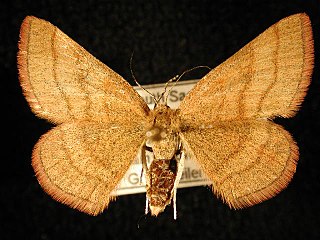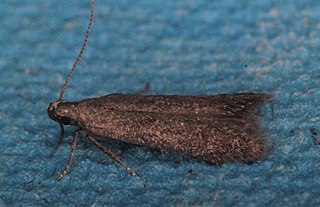
Polygonum is a genus of about 130 species of flowering plants in the buckwheat and knotweed family Polygonaceae. Common names include knotweed and knotgrass. In the Middle English glossary of herbs Alphita, it was known as ars-smerte. There have been various opinions about how broadly the genus should be defined. For example, buckwheat has sometimes been included in the genus as Polygonum fagopyrum. Former genera such as Polygonella have been subsumed into Polygonum; other genera have been split off.
The lignans are a large group of low molecular weight polyphenols found in plants, particularly seeds, whole grains, and vegetables. The name derives from the Latin word for "wood". Lignans are precursors to phytoestrogens. They may play a role as antifeedants in the defense of seeds and plants against herbivores.

Polygonum arenastrum, commonly known as equal-leaved knotgrass, is a summer annual flowering plant in the knotweed family Polygonaceae. Other common names include common knotweed, prostrate knotweed, mat grass, oval-leaf knotweed, stone grass, wiregrass, and door weed, as well as many others. It is native to Europe and can be found on other continents as an introduced species and a common noxious weed. Knotweed was first seen in North America in 1809 and is now seen across much of the United States and Canada.
This article gives an overview of the plant communities formed by vegetation of open habitats in the British National Vegetation Classification system.

Betulinic acid is a naturally occurring pentacyclic triterpenoid which has antiretroviral, antimalarial, and anti-inflammatory properties, as well as a more recently discovered potential as an anticancer agent, by inhibition of topoisomerase. It is found in the bark of several species of plants, principally the white birch from which it gets its name, but also the ber tree, selfheal, the tropical carnivorous plants Triphyophyllum peltatum and Ancistrocladus heyneanus, Diospyros leucomelas, a member of the persimmon family, Tetracera boiviniana, the jambul, flowering quince, rosemary, and Pulsatilla chinensis.

Polygonum aviculare or common knotgrass is a plant related to buckwheat and dock. It is also called prostrate knotweed, birdweed, pigweed and lowgrass. It is an annual found in fields and wasteland, with white flowers from June to October. It is widespread across many countries in temperate regions, apparently native to Eurasia, naturalized in temperate parts of the Southern Hemisphere.
Panonychus ulmi, the European red mite, is a species of mite which is a major agricultural pest of fruit trees. It has a high reproductive rate, a short generation time and produces many broods in a year, all of which contribute to its pest status. It has a cosmopolitan distribution, and a very wide host range, having been found on the following plants:

Myricitrin is a plant compound, the 3-O-α-L-rhamnopyranoside of myricetin.

Enterolactone is a organic compound classified as an enterolignan. It is formed by the action of intestinal bacteria on plant lignan precursors present in the diet.
British NVC community OV8 is one of the open habitat communities in the British National Vegetation Classification system. It is one of eight arable weed and wasteland communities of fertile loams and clays.
British NVC community OV10 is one of the open habitat communities in the British National Vegetation Classification system. It is one of eight arable weed and wasteland communities of fertile loams and clays.
British NVC community OV15 is one of the open habitat communities in the British National Vegetation Classification system. It is one of two arable weed communities of light lime-rich soils.
British NVC community OV16 is one of the open habitat communities in the British National Vegetation Classification system. It is one of two arable weed communities of light lime-rich soils.

Augasma aeratella is a moth of the family Coleophoridae. It is found in most of Europe. The habitat consists of open landscapes of forest-steppe and steppe biotopes.

Panicudine (6-hydroxy-11-deoxy-13-dehydrohetisane) is a C20-diterpene alkaloid of the hetisine type, first isolated from Aconitum paniculatum. It has empirical formula C20H25NO3 and a melting point of 249–250 °C. The structure was determined to be a hetisine type diterpene by noting infrared spectrum absorption bands of 3405 cm−1 (OH), 1718 (C=O), and 1650 (C=C), a proton magnetic resonance spectrum with "secondary hydroxy (4.02 ppm, m, 1H, W1/2 = 10 Hz), exomethylene (4.87 and 4.76 ppm, br.s, 1H each), and tertiary methyl (1.29 ppm, s, 3H) groups and the absence of N-methyl, N-ethyl, and methoxy groups." Additional ultraviolet spectrum and carbon-13 NMR data, confirmed by high resolution mass spectrometry, completed the determination of the structure.

Scopula sentinaria is a moth of the family Geometridae. It is found from Alaska to Labrador, south in the prairies to southern Manitoba, Saskatchewan, Alberta and British Columbia. In the mountains it ranges south to Colorado. The species is also found in northern Russia and the Sayan Mountains. The habitat consists of dry shrubby clearings and edges.

Avicularin is a bio-active flavonol isolated from a number of plants including Polygonum aviculare, Rhododendron aureum and Taxillus kaempferi.

Juglanin is a flavonol found in Polygonum aviculare.
Polygonum agreste is a species of flowering plant in the family Polygonaceae, native to Uzbekistan. It was first described by Georgji Sumnevicz in 1940.

Monochroa hornigi, the knotweed neb, is a moth of the family Gelechiidae. It was described by Otto Staudinger in 1883. It is found in most of Europe, European Russia, western and south-eastern Siberia, Transbaikalia, Korea and Japan (Hokkaido).










